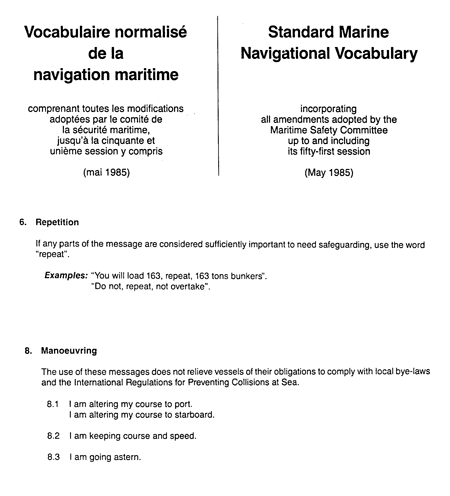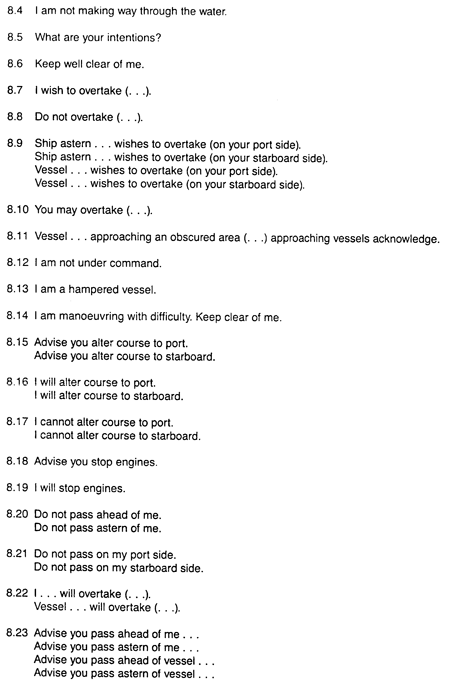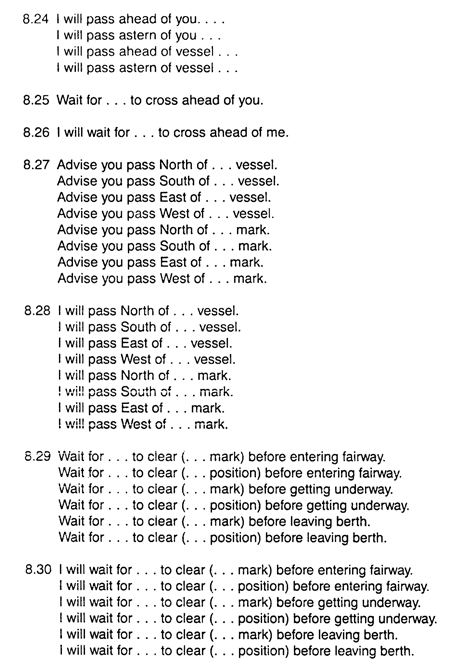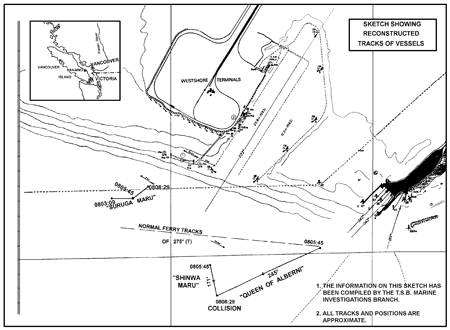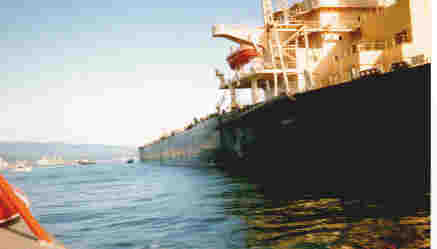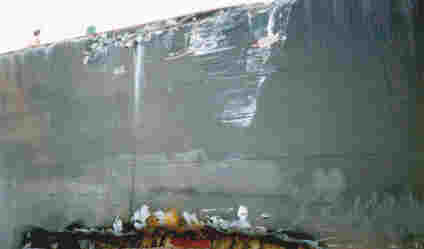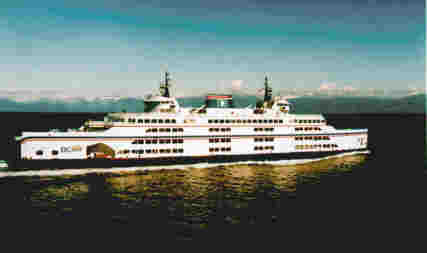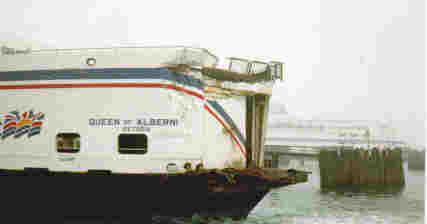Collision
Between the Ferry "QUEEN OF ALBERNI"
and the Bulk Carrier "SHINWA MARU"
Strait of Georgia, British Columbia
The Transportation Safety Board of Canada (TSB) investigated this occurrence for the purpose of advancing transportation safety. It is not the function of the Board to assign fault or determine civil or criminal liability. This report is not created for use in the context of legal, disciplinary or other proceedings. See Ownership and use of content. Masculine pronouns and position titles may be used to signify all genders to comply with the Canadian Transportation Accident Investigation and Safety Board Act (S.C. 1989, c. 3).
Summary
On 12 March 1992, the Canadian ferry "QUEEN OF ALBERNI", under the conduct of the master, departed from Tsawwassen, British Columbia, bound for Nanaimo, British Columbia, and the Japanese bulk carrier "SHINWA MARU", under the conduct of a British Columbia coast pilot, departed from Roberts Bank Terminal (Westshore Terminals) en route to the Victoria Pilot Station. The vessels collided approximately one nautical mile south-west of Tsawwassen Ferry Terminal in daylight, with calm weather conditions and visibility reduced by fog.
The Board determined that the "QUEEN OF ALBERNI" and the "SHINWA MARU" collided in dense fog because all available means were not used by both vessels to assess risk of, and avert, collision in a rapidly developing close-quarters situation.
1.0 Factual Information
1.1 Particulars of the Vessels
| QUEEN of ALBERNI | SHINWA MARU | |
|---|---|---|
| Official number | 370066 | 130164 |
| Port of registry | B.CFootnote 1 | Japan |
| Flag Type | Canadian | Japanese |
| Gross TonsFootnote 2 | 5,872 | 87,183 |
| Length | 139.35 m | 290.0 m |
| Breadth | 27.13 m | 45.0 m |
| Draught | 5.03 m | 16.06 |
| Built | 1976 Vancouver Shipyards Co. LTD. Vancouver B.C. | 1987, Mitsui Eng. and SB Co. Chiba Ichihara, Japan |
| Propulsion | Two Mak, 4SA diesel 12-cyl. engines, driving two propellers (11,860 BHP) | One B7W, 2SA diesel 5-cyl. engine driving onr propeller (17,700 BHP) |
| owners | British Columbia Ferry Corporation Victoria B.C. | Shinwa K.K Ltd. Tokyo, Japan |
1.1.1 Description of the Vessels
"QUEEN OF ALBERNI"
The "QUEEN OF ALBERNI" is a double-ended ferry. A navigation bridge...
...and a wheel-house are located some 42 m from each end. The "forward" end is considered to be that end from which the vessel is being navigated. The vessel's main propulsion consists of two diesel engines with a total output of 11,860 BHP driving a single, right-handed, controllable-pitch (CP) propeller at each end. The main engines and shafts are unidirectional, and ahead and astern are obtained by blade pitch adjustments. The vessel has a rudder at each end.
For normal navigation between ports, the vessel is operated in mode 1, in which all power is transmitted to the aft propeller and bridge control is by a "T" handle control, giving the vessel the following speeds:
| POWER | RPM | SPEED |
|---|---|---|
| 25% | 153 | 13.5 kn |
| 50% | 166 | 18.0 kn |
| 75% | 173 | 20.5 kn |
| 100% | 197 | 22.8 kn |
For manoeuvring, the vessel is placed in mode 2, in which control of the forward propeller is achieved by an "L" handle control, and separate control of the aft propeller is accomplished using the "T" handle control. When the "L" handle control is used in mode 2, an ahead setting on the propeller pitch gives the vessel a braking effect and an astern setting assists in propelling the vessel forward.
"SHINWA MARU"
The fully automated "SHINWA MARU" is fitted with a bulbous bow. The crew accommodation, bridge and engine-room are located aft of the nine cargo hatches. The navigation bridge is positioned 247 m from the bow and 43 m from the stern. The conning position provides an unrestricted view forward. Engine control is by electric telegraph which transmits orders to a second console, also in the wheel-house, where an engineer operates the main engine. The vessel's designed service speed is about 14 knots (kn).
1.2 Description of the Occurrence
"QUEEN OF ALBERNI"
After loading passengers and vehicles, the "QUEEN OF ALBERNI" departed Tsawwassen No. 5 dock at 0801Footnote 3 on 12 March 1992Footnote 4, in fog and near-zero visibility. Two radars were operational and the vessel was on hand-steering. Appropriate fog signals were sounded and a look-out was posted forward on the upper deck. The vessel left the No. 5 dock on a course approximately parallel to the dock's main axis 223° true (T). After the last dolphin in the west wall was cleared, the course was altered to 240° gyro (G) rather than the normal 275° (T) to allow two vessels, observed on the radar to be in the nearby northbound traffic lane, to pass ahead. No gyro error was reported.
At 0805, the engine-room was notified that the vessel was on "full away", but that the engines would remain on "stand-by" due to reduced visibility. At 0806, the engine control was switched to mode 1. Reportedly, for the brief period before collision, the vessel had reached a speed of about 8 kn which is equivalent to a CP setting of "4" on the telegraph. The speed on the doppler log located in the wheel-house was not observed. Following radio communication with the "SHINWA MARU" and without positively identifying her on the radar plan position indicator (PPI), the vessel continued on passage. Before the collision, the CP was set to "0" then reversed to "full astern", but this action was too late. The vessels collided at 0808. The bow of the "QUEEN OF ALBERNI" contacted the port side of the "SHINWA MARU" some 25 m aft of the forward perpendicular and some 3 m above the waterline. The angle of impact was about 70°.
"SHINWA MARU"
On 12 March 1992, the "SHINWA MARU" was port side to alongside Westshore Terminal No. 1, Roberts Bank, B.C., on a heading of 108° (T), where she completed loading 147,743 tonnes of coal shortly before 0700. A B.C. coast pilot, five tugboats and one mooring boat were in attendance. The vessel commenced "singling up" at 0715 and cleared the wharf at 0740. With the vessel heading 150° (T), four of the tugs were dismissed and the vessel was under her own propulsion. Because visibility was reduced, three crew members were positioned forward as look-outs and the automatic fog signal was activated.
With the one remaining tugboat secured to her starboard bow, the "SHINWA MARU" was increasing engine revolutions per minute (RPM) and altering course to starboard with the intention of entering the southbound traffic lane.
At 0800, with the vessel heading approximately 170° (T) at a speed of about 3 kn, the last tugboat was dismissed. Shortly afterward, at 0801, the "QUEEN OF ALBERNI" was heard reporting her departure from Tsawwassen ferry terminal to the Vessel Traffic Services (VTS). At 0806, the vessel established very high frequency radiotelephone (VHF R/T) contact with the "QUEEN OF ALBERNI" to arrange safe passage, but at 0808, the vessels collided. The speed of the "SHINWA MARU" was about 4.5 kn.
1.2.1 Events Following Collision
Immediately after the collision, both vessels assessed their damage. They maintained radio contact and, after ensuring that neither vessel was in need of immediate assistance, each proceeded to port; the "QUEEN OF ALBERNI" to Tsawwassen Terminal and the "SHINWA MARU" to a safe anchorage in English Bay. Following the collision, the public address (PA) system on the ferry was used to keep the passengers informed, and first aid was rendered to the injured persons. Meanwhile, emergency vehicles were summoned. As soon as the ferry docked, emergency personnel attended to the injured passengers and crew. No person from the ferry was designated to guide the emergency response teams and to direct their efforts which resulted in some delay in evacuating the injured passengers.
1.3 Injuries to Persons
"QUEEN OF ALBERNI"
| Crew | Passengers | Others | Total | |
|---|---|---|---|---|
| Fatal | - | - | - | - |
| Missing | - | - | - | - |
| Serious | - | 2 | - | 2 |
| Minor/None | 25 | 233 | - | 258 |
| Total | 25 | 235 | - | 260 |
None of the 11 crew members of the "SHINWA MARU" were injured.
1.4 Damage
The ferry sustained structural damage to the shell plating, main deck apron, upper deck and sliding doors; all at No. 1 end. Some metal cabinets and food counters in the vessel's cafeteria, which were secured to the deck, had sheared off at the base and were displaced.
The overhanging main deck plating of the "QUEEN OF ALBERNI" penetrated the port side shell plating in way of the No. 1 cargo hold and No. 1 topside ballast tank on the "SHINWA MARU". Plating was set in heavily and torn open in the respective compartments. Several frames, associated members and air pipes in way were also damaged.
1.5 Vessel Certification
Both vessels were certificated, equipped and manned in accordance with existing regulations.
1.5.1 Personnel Certification and History
The master and officers of both vessels were in possession of certificates that were valid for their positions and for the trade in which they were engaged.
The pilot on the "SHINWA MARU" held a Canadian Master 350 Tons Certificate of Competency issued in 1977 and a B.C. Coast Pilot's Licence. He had attended the Vessel Handling Course in Port Revel, France, in 1986. The pilot had some six years' pilotage experience on the B.C. coast. Before he became a pilot, his sea experience consisted of service on B.C. coast tugs in various capacities.
"QUEEN OF ALBERNI"
The master joined the British Columbia Ferry Corporation (BCFC) in 1965. He had sailed in various capacities, working his way up the ranks and, since 1982, had served in the capacity of chief officer/relief master on large vessels. He had been sailing on this vessel and on the
Nanaimo-Tsawwassen route since 1991.
The officer of the watch (OOW) had approximately 20 years of sea service on BCFC vessels. Since 1986, he had been acting as watchkeeping officer on various ferries and routes.
"SHINWA MARU"
The master had approximately 27 years of sea service on various cargo vessels, of which about 11 years were in the capacity of master, including eight months on this vessel.
The OOW had approximately
20 years of sea service on various cargo vessels as either deck or radio officer, and seven months on the "SHINWA MARU" in a dual capacity as a deck and radio officer.
1.6 Weather and Tidal Information
1.6.1 Forecasts
The marine forecast issued by the Pacific Weather Centre of Environment Canada at 0445 PST on 12 March 1992, for the Strait of Georgia was:
Winds light. Visibility near zero in extensive fog. Outlook, light to moderate southeasterlies.
1.6.2 Weather as Reported by the Vessels
Both vessels reported a light north-westerly wind, rippled sea and visibility reduced by fog. The "SHINWA MARU" reported that the visibility was about 90 m (½ cable), and the "QUEEN OF ALBERNI" defined the visibility as zero.
1.6.3 Tide and Current
The collision occurred some 1 hour 17 minutes before high water at Tsawwassen. The tidal range was 0.2 m. There was no evidence to suggest that the current was a factor in this occurrence.
1.7 Navigation Equipment
"QUEEN OF ALBERNI"
The vessel was equipped with two Sperry radars in each wheel-house. A conventional radar was located on the port side and a Rasterscan (RASCAR), equipped with a Collision Avoidance System (also referred to as Automatic Radar Plotting Aid (ARPA)), with a 340 mm diameter display on the starboard side. Both radars were functional and operating, but only the RASCAR was in use. The RASCAR, according to the manufacturers, is a solid-state, computer-controlled, radar system which encompasses advanced digital techniques to reduce clutter and eliminate false target signals.
A wheel-house logbook entry made some 30 minutes before the collision shows that there was no deficiency with respect to machinery, navigation and safety equipment. However, following the collision, the master reported that the persistence of a "clutter" resulted in the echo of the "SHINWA MARU" not being detected. Following the collision, the radar was checked for performance and found to be functioning satisfactorily.
"SHINWA MARU"
The navigation equipment aboard the vessel included two radar sets. All navigation equipment was reported to be in good working order. The "SHINWA MARU" tracked the "QUEEN OF ALBERNI" on its radar prior to the collision.
1.8 Radio Communication
1.8.1 Vessel Traffic Services (VTS) and/or Coastal Radio Station
At 0703, the "SHINWA MARU" informed Vancouver VTS of her intention to depart in 15 minutes, at which time VTS indicated that no other traffic had been cleared to depart. At 0756, VTS was informed that the "SHINWA MARU" was off the berth and under way, heading toward the traffic lane. VTS advised the vessel of the traffic in the vicinity, but there was no mention of the "QUEEN OF ALBERNI".
At 0801, the "QUEEN OF ALBERNI" reported to VTS that she was just departing Tsawwassen Terminal. VTS informed her of the traffic in the vicinity including the presence of the "SHINWA MARU", just away from Roberts Bank Terminal, southbound; the "SURUGA MARU", awaiting the former's berth; and three northbound vessels approaching the ferry route. The message was acknowledged and no detailed position information was sought.
1.8.2 Inter-ShipFootnote 5
The first radio contact between the two vessels was initiated by the "SHINWA MARU" at 0806 and, about two minutes later, the vessels collided. Highlights of the communication between the vessels included the following:
Time Station Text
08:06:22SM "... You can see me out here ...?"
08:06:27QA "... We know you are there, ... wish us to slow down or may we cross your bow?"
08:06:32SM "I'm only doing about 5 knots but I'm coming up to full so you go ahead, it's your pleasure there."
08:06:39QA "OK, we'll slow down ..."
08:06:46SM "Well, you can go ahead of me if you want but I'm picking up speed here. It will be quite a while before I'm up to speed but, like I say, I'm working her up."
08:07:15QA "We'll keep our eye on you and stay clear of you."
08:07:40SM "You seem to be coming right at me ..."
08:07:58QA "We're stopping "SHINWA MARU".
08:08:37 SM "... You just smacked into us."
1.8.3 Maritime Vocabulary
The Standard Marine Navigational Vocabulary was not used by either vessel to communicate.
The International Maritime Organization (IMO) Resolution A.474(XII), adopted on 19 November 1981, entitled Proper Use of VHF Channels at Sea, encourages the use of the Standard Marine Navigational Vocabulary. The use of the latter publication in communications is intended to eliminate misunderstanding, which is crucial for operational safety. The manoeuvring terminology contained in the vocabulary ensures that each vessel is fully aware of the intentions of the other and it eliminates indecisiveness. It emphasises the need to repeat any part of the message which is considered to be sufficiently important to need safeguarding e.g. "Do not, repeat, not cross ahead." Further, it reiterates that where a message contains instructions or advice, the receiving station acknowledging the message should repeat the substance (See Appendix A).
1.9 Vessel Traffic Services (VTS)
Both the "SHINWA MARU" and the "QUEEN OF ALBERNI" participated in the VTS system. All vessels in the vicinity of Tsawwassen-Roberts Bank terminals were monitored on the Vessel Traffic Centre (VTC) radar. Their positions as determined by the VTC radar tracker were logged by the Central Processing Unit (CPU) and known to the Marine Traffic Regulator (MTR).
The VTC tracker records all tagged targets' positions at a predetermined time interval. The accepted VTC practice is to "park" the tags in a non-traffic area when a vessel is alongside a berth. Only when a MTR links the tag to its target, does the tracker commence logging the updated coordinates.
The assigned tag "N92Q" to the "QUEEN OF ALBERNI" was linked to the target at 08:03:09 and the "K32K", to the "SHINWA MARU" at 08:05:45. The targets were logged by the automatic computer logger at an interval of about two and a half minutes.
VTC Recording
All VTC automatically recorded times and positions are within one second accuracy in time/Latitude/Longitude.
The VTC tracker logged merging of the two targets in position 48°59'44"N, 123°09'34"W, i.e. 1.1 nautical miles (M) 237.5° (T) from Tsawwassen dock No .5 entrance light, at 08:08:28.
1.10 Reconstructed Tracks of the Vessels
Both vessels had just departed the harbour limits. There was minimal information regarding plotted positions on Canadian Hydrographic Service (CHS) chart No. 3463 or in the deck logbooks.
The TSB reconstructed the tracks of the "SURUGA MARU", the "SHINWA MARU" and the "QUEEN OF ALBERNI" based on the information provided by the vessels and/or VTC (see Appendix B). An examination of the tracks indicated the following:
- At 0806, the "SHINWA MARU and the "QUEEN OF ALBERNI" were approximately 0.73 M apart and the "SHINWA MARU" was some 20° on the starboard bow of the "QUEEN OF ALBERNI" bearing about 260°. The "SURUGA MARU" was some 1.25 M, bearing about 287° from the "QUEEN OF ALBERNI", and was headed in an easterly direction at about 3 kn.
- The courses and speeds made good by the "QUEEN OF ALBERNI" were 225½° (T) and 6.42 kn between 0801 and 0806, and 245° (T) and 15.65 kn between 0806 and the time of collision, respectively.
- The courses and speeds made good by the "SHINWA MARU" from 0801 to 0806 were 186° (T) and 4.07 kn, and 171° (T) and 4.45 kn from 0806 until the time of collision, respectively.
- There was virtually no change in the bearing between the two vessels.
1.11 Bridge Manning and Conduct of Navigation
"QUEEN OF ALBERNI"
Some four minutes prior to sailing, the master had acquired four or five targets on the ARPA, one of which was later identified to have been the "SURUGA MARU". He had also observed the presence of two distinct areas of persistent "clutter". He attributed the clutter variously to a disturbance caused by the wake of tugs assisting a large vessel, a herring boil with birds feeding on it, and later to a multiple/spurious echo. He was unsuccessful in his attempt to eliminate the clutter.
At the time of departure of the "QUEEN OF ALBERNI", the bridge was manned by the master who had the conduct with the quartermaster at the helm. As the vessel moved away from the dock, the OOW arrived in the wheel-house and was instructed by the master to locate the "SHINWA MARU" on the radar. He used the same ARPA set as the master and, apart from attempts at interpreting the picture and acquiring an area of "clutter", no other adjustments were carried out. Approximately two minutes later, the OOW left the radar to handle all radio communications, with the master now monitoring the radar. A very large target just beyond the clutter with no appreciable vector or heading, later identified to be the "SURUGA MARU", was observed on the ARPA and was assumed, albeit mistakenly, to be the "SHINWA MARU".
"SHINWA MARU"
Before departure, the master and the pilot discussed the unberthing procedures and the passage from Roberts Bank to the Victoria Pilot Station. The master monitored the vessel's progress using one of the two radars, and the OOW primarily ensured that the pilot's orders were carried out. The passing arrangement between the "SHINWA MARU" and the "QUEEN OF ALBERNI" was not effectively monitored or questioned.
1.11.1 Collision Regulations
The safety and conduct of vessels in restricted visibility, as set out in the International Regulations for Preventing Collisions at Sea (COLREGS), should be governed so that, among other things:
- a "proper look-out" by "all available means" is maintained to make a "full appraisal" of the risk of collision;
- in determining risk of collision, "all available means" are used and, when in doubt, risk of collision is deemed to exist;
- where fitted and operational, "proper use" is made of the radar equipment, including "radar plotting or equivalent systematic observation of detected objects" and "assumptions" are not made on "scanty information";
- appropriate fog signals are sounded and vessels proceed at a "safe speed" having due regard to "the prevailing circumstances" and visibility. A vessel which "detects by radar alone" the presence of another vessel is to determine if a "close-quarters situation" is developing and/or risk of collision exists. If so, "avoiding action in ample time" is to be taken and vessels navigated with extreme caution until the danger of collision is over"; and
- in determining "safe speed", consideration is given, among others, to the visibility, the density of traffic and the limitations of a radar set.
Further, good watchkeeping practices as outlined in the IMO Resolution A.285(VIII), entitled Recommendation on Basic Principles and Operational Guidance Relating to Navigational Watchkeeping, recommends that:
- the presence of the pilot on board "does not relieve" the master or the OOW from their "duties and obligations for the safety of the ship", and
- the OOW makes "most effective use" of all navigational equipment at his/her disposal.
In this instance, a total of eight vessels were navigating in the area in fog and near-zero visibility. Look-outs were posted forward on the "QUEEN OF ALBERNI" and the "SHINWA MARU". The average speed, during the two and a half minutes prior to the collision, as calculated, was 15.65 kn for the "QUEEN OF ALBERNI" and of 4.45 kn for the "SHINWA MARU". VHF R/T contact was established between the vessels to arrange a safe passage, but the communication conveyed indecisiveness, and there was limited time to effectively monitor the evolving situation. Overemphasis was placed on the VHF arrangement and more effective use was not made of other available means to avert collision.
The "QUEEN OF ALBERNI" was aware of the presence of two large vessels in the area of Westshore Terminal, both forward of her beam. Only one radar echo on the PPI was recognized as being that of a vessel, and the apparent absence of a second echo in the vicinity was not questioned. Instead, it was assumed that the "SURUGA MARU" was the "SHINWA MARU", and the "QUEEN OF ALBERNI" continued on her passage. Only when the "SHINWA MARU" informed the "QUEEN OF ALBERNI" that the ferry was headed straight for her, did the "QUEEN OF ALBERNI" take last minute action. This action, which comprised setting the CP to zero and then engaging reverse propulsion, was taken too late to avert collision. No action was initiated by the "SHINWA MARU".
Each vessel sounded the prescribed fog signals. The fog signal heard by the forward crew on the "SHINWA MARU" was not reported to the bridge.
There was conflicting evidence regarding the fog signals as received on board the "QUEEN OF ALBERNI". The look-out maintained that he heard a fog signal coming from the vessel's starboard side which he reported to the bridge. Communication between the look-out and the wheel-house was by means of a portable radio and a telephone installation. The bridge personnel maintained having neither received the look-out's message nor heard any fog signal. The look-out reported that, following the collision, the OOW had indicated that all messages from the vessel's bow were received loud and clear.
At least three passengers on the ferry, who were seated on the upper deck lounge and overlooking the bow, reported that they saw the look-out on the vessel's bow talking on his radio, pointing to starboard and running aft approximately one minute before the collision. One passenger reported having heard a fog signal other than that of the "QUEEN OF ALBERNI".
1.12 Ferry Schedule
At the time of the occurrence, the sailing schedule for the "QUEEN OF ALBERNI" was as follows:
| DEPARTURE NANAIMO | DEPARTURE TSAWWASSEN |
|---|---|
| 0530 | 0800 |
| 1030 | 1300 |
| 1530 | 1800 |
| 2030 | 2300 |
The distance between ports is about 38 M and the service speed of the vessel is 20 kn. Thus, the steaming time for the passage of 1 hour and 54 minutes does not take into consideration the weather and current. Hence, the ferry is left with some 36 minutes to carry out berthing and unberthing procedures and to discharge and load vehicles and passengers.
During the hearings of the 1992 Nemetz Inquiry following a fatal accident involving a BCFC vessel, there was considerable testimony about the impact of the current schedules on safety. The report of the Commission included a recommendation, Recommendation 13, that a joint task force review scheduling and its impact upon safety. The report of the task force, in May 1993, stated, in part, that the group had found that ferry turnaround time "... gave essentially no room for flexibility ..." placing personnel "... in the position of having to "catch-up" and having essentially no slack in which to do it." The task force data indicated that "... some catching up is possible, but by no means all ... with the very limited ability of the ships to make up lost time." The group was of the opinion that "keeping on time is the single most visible indicator of performance within the BCFC ..." and felt that "... safety is especially vulnerable when decisions are taken under pressure to maintain a schedule." The report continued that, barring changes, "... substantial pressure to maintain the schedule will always remain part of the everyday experience", and the report cited employees as perceiving "... strong signals from "above" that it is the schedule that mattered above all else." The task force report was made to the Board of the British Columbia Ferry Corporation.
2.0 Analysis
2.1 Radar Performance
Improper adjustment of the radar set could produce strong multiple/spurious echoes owing to the proximity of the two terminals or spurious but relatively weak echoes from adverse weather conditions or marine life. A proper adjustment of the radar controls can help the radar operator minimize these effects on the PPI thereby enabling him to detect closer targets. In any event, echoes from marine life cannot conceal strong radar returns from a large steel vessel, presenting a beam-on target, such as the "SHINWA MARU". However, multiple echoes associated with the terminals could make it difficult to differentiate such echoes.
2.1.1 Misidentification of the
"SHINWA MARU"
One of the targets acquired on ARPA by the master of the "QUEEN OF ALBERNI" some four minutes before the vessel's departure was that of the "SURUGA MARU", but, reportedly, the "SHINWA MARU" had not been acquired. Thus, a perusal of the read-out on the ARPA screen at that time should have included information on the course and speed of the "SURUGA MARU" or would have at least indicated a motion trend. Further, the master indicated that the "SHINWA MARU" was lost in the clutter and could not be identified. He, nonetheless, associated the clutter with the wake of tugs assisting a large vessel. This would suggest that the master had initially considered the clutter to have been associated with the "SHINWA MARU". Nevertheless, the echo of the "SURUGA MARU" was apparently taken to be that of the "SHINWA MARU", and the "QUEEN OF ALBERNI" was manoeuvred on this assumption.
2.2 Conduct of Navigation
Although two radars were operational and available to the bridge team aboard the "QUEEN OF ALBERNI", only one radar was used by both the master and the OOW. It is not known why the bridge personnel was unable to effectively remove the clutter on the PPI. The second radar was not utilized. As the information presented on the PPI aboard the "QUEEN OF ALBERNI" had not been verified against that received on the VHF R/T, crucial information was missing respecting another vessel in the vicinity that could jeopardize thesafety of the vessel. Precise information was not requested by the "QUEEN OF ALBERNI" from either VTS or the "SHINWA MARU" to positively identify the vessel on the PPI to assess risk of collision. Different persons were handling the radar and the VHF, and their efforts were not coordinated.
2.3 Situation Assessment by the "QUEEN OF ALBERNI"
The "QUEEN OF ALBERNI" was steadied on a course of 240° (G), reportedly to allow two targets in the northbound traffic lane, some three to four miles away, to pass ahead, but no effective action was taken to keep clear of the "SHINWA MARU", positioned barely a mile away. This would suggest that there was no immediate concern for traffic close at hand which would require prompt/timely action. While departing Tsawwassen Terminal, the bridge team on the "QUEEN OF ALBERNI" was aware of the presence of the "SHINWA MARU" and was apprised by VTS that the "SURUGA MARU" was located off Westshore Terminals.
The distance between the Westshore Terminals and the Tsawwassen Terminal is 1.1 M, and consequently, the distance between the "QUEEN OF ALBERNI" and the two vessels would have been over 1 M and decreasing rapidly as the vessels gathered headway.
The "QUEEN OF ALBERNI" neither significantly reduced speed nor stopped, either to assess the situation or to avert the already existing close-quarters situation with the "SHINWA MARU". The operation of the main engines was changed from mode 2 to mode 1.
The situation, as assessed by the "QUEEN OF ALBERNI", was that the movement of the "SURUGA MARU" did not pose an immediate threat. Thus, no evasive action was considered necessary and the "QUEEN OF ALBERNI" inadvertently proceeded to cross ahead of the "SHINWA MARU", the echo of which had not been been properly identified. However, when it was realized that no southbound vessel had been identified on the PPI and that the "SHINWA MARU" must indeed be within the clutter, the CP of the "QUEEN OF ALBERNI" was set at zero and then propulsion was reversed.
2.3.1"SHINWA MARaU" - Lack of Assertiveness/Direction
The "SHINWA MARU", a fully loaded bulk carrier, constrained by her size and in the process of gaining speed, was capable of neither turning nor stopping at a rate which would significantly reduce the existing risk of collision with the "QUEEN OF ALBERNI". The "SHINWA MARU" did not assertively direct the "QUEEN OF ALBERNI" to pass astern of her, in the close-quarters situation.
2.3.2 Situation Assessment by the TSB
The reconstructed tracks show that, at 0806, the "SHINWA MARU" was about 20° on the starboard bow of the "QUEEN OF ALBERNI" at a range of 0.73 M. At the same time, the "SURUGA MARU" was some 40° on the starboard bow at a distance of about 1.25 M. With the "QUEEN OF ALBERNI" and the "SHINWA MARU" building up speed and the "SURUGA MARU" moving at about 3 kn, the "QUEEN OF ALBERNI" could not have seen appreciable change in radar vectors in a one-minute period. Further, a review of the tracks indicated that:
- a persistent clutter, which had reportedly precluded identification, later turned out to be the echo of the "SHINWA MARU"; and
- a second very large target just beyond the clutter had later turned out to have been the "SURUGA MARU".
Hence, the lack of knowledge of the relative positions of the other vessels in conjunction with the recent radio communication could likely have caused some concern aboard the "QUEEN OF ALBERNI" in the rapidly developing collision situation. Had the normal track been taken after leaving Tsawwassen, the "QUEEN OF ALBERNI" could have proceeded at a course and speed such that she would have passed astern of the "SHINWA MARU" and to the south of the "SURUGA MARU" which was manoeuvring northward toward the berth.
As the VHF was monitored aboard the "QUEEN OF ALBERNI", she was aware of the presence of the "SHINWA MARU" and the "SURUGA MARU" before her departure. She did not positively identify both vessels on the radar, establish their courses and speeds, and arrange safe passage before departing from the wharf.
2.4 Lack of Definitive Language Used in Communication
Some two minutes before the collision, the "QUEEN OF ALBERNI" indicated her intention to slow down and let the "SHINWA MARU" pass ahead. At this stage, the pilot of the "SHINWA MARU" informed the "QUEEN OF ALBERNI" that she could "pass ahead if she wanted". Thus, the apparent attempt by the "QUEEN OF ALBERNI" to cross ahead could probably have been influenced, in part, by the use of imprecise language that conveyed indecisiveness and was also based on scanty information.
2.5 Speed Discrepancy
For all practical purposes, the speed of the "SHINWA MARU" as reported by her was consistent with that derived from the plot confirming the reliability of the VTC recorded positions.
Once clear of the wharf, the general practice followed by the "QUEEN OF ALBERNI" was to increase speed. This is consistent with the change in the operation of the main engines from mode 2 to mode 1. In the absence of recorded engine movements, it is not possible to verify the precise times and corresponding CP settings from the time of the vessel's departure. While the master estimated that the "QUEEN OF ALBERNI" reached a maximum speed of about 8 kn, the reconstructed track of the vessel showed that, in the last two and a half minutes before the collision, the vessel averaged a speed of 15.65 kn; this despite setting the engine controls to zero about 45 to 60 seconds before the collision and eventually engaging reverse propulsion. It should be noted that the average speed of the vessel from departure at 0801 until collision at 0808 was 9.94 kn, not taking into account the time required for acceleration and the period of time that had elapsed between the CP being set to zero and the time of collision. The "SHINWA MARU" was not positively identified on the PPI aboard the ferry, and the collision occurred despite reverse propulsion.
2.5.1 Look-out
Although three look-outs, who were positioned forward on the "SHINWA MARU", heard the fog signal of the approaching "QUEEN OF ALBERNI", none of them reported it to the bridge. It is not known why the bridge personnel on board the "QUEEN OF ALBERNI" neither heard the sound signal from the approaching "SHINWA MARU" nor acknowledged receipt of the fog signal reported by the forward look-out.
2.5.2 Use of Very High Frequency Radiotelephone for Collision Avoidance
The bridge teams on both vessels did not exercise caution, nor did they make greater and more effective use of other available means to ascertain risk of collision. Instead, they mainly relied on the information obtained by VHF R/T and a presumed mutual understanding. It should be noted that instances are on record wherein improper and solitary use of VHF R/T by either one or both vessels in an attempt to avoid collision has proven dangerous. On the other hand, VHF R/T, when properly used in conjunction with other aids to navigation and in compliance with the COLREGS, can enhance safety. Hence, when VHF R/T is used for collision avoidance purposes, extreme caution must be exercised to ensure that:
- both vessels are positively identified;
- precise and unambiguous language as contained in the Standard Marine Navigational Vocabulary is used at all times;
- passing arrangements are made in ample time to ensure that valuable time is not wasted; and
- the course of action is in compliance with the COLREGS.
2.6 Perception and Decision Making
Ferries transport large numbers of passengers and vehicles and operate on tight schedules, a situation which can create a sense of underlying pressure to maintain the schedule, and masters constantly endeavour to avoid delays, as much as possible. Once delayed, it would be difficult for a ferry to regain her schedule for the day. It cannot be determined if the consequences of any delay was one of the issues influencing the master's decisions. In this instance, the fact that the pilot of the "SHINWA MARU" indicated to the master of the "QUEEN OF ALBERNI" that the latter could pass ahead if he so desired, may have led to a tendency for the threat posed by the close-quarters situation, as perceived by the master of the "QUEEN OF ALBERNI", to be somewhat downplayed. Since the distance separating the two vessels was less than a mile, by the time the danger was realized, collision was imminent.
3.0 Findings
3.1 Findings
- The "QUEEN OF ALBERNI" departed from her berth in reduced visibility after the "SHINWA MARU" had sailed from an adjacent terminal.
- The "QUEEN OF ALBERNI" took a more southerly course than her normal track.
- The course chosen by the "QUEEN OF ALBERNI" exacerbated the close-quarters situation with the "SHINWA MARU".
- The "QUEEN OF ALBERNI" did not positively identify the "SHINWA MARU" on radar and incorrectly assumed that the echo of the "SURUGA MARU" was that of the "SHINWA MARU".
- The "QUEEN OF ALBERNI", proceeding at an average speed in excess of 15 knots prior to the collision, did not request from either Vessel Traffic Services (VTS) or the "SHINWA MARU" precise information on the latter's position to enable her to be positively identified on the plan position indicator (PPI).
- The apparent absence of the second echo on the PPI aboard the "QUEEN OF ALBERNI" was not questioned.
- The information as presented on the radar aboard the "QUEEN OF ALBERNI" was not verified against the information received on very high frequency radiotelephone (VHF R/T).
- The precise manoeuvring terminology in the Standard Marine Navigational Vocabulary was not used, and neither vessel made decisive passing arrangements.
- The use of imprecise language and the misidentification of the "SHINWA MARU" tended to downplay somewhat the threat posed by the risk of collision on board the "QUEEN OF ALBERNI".
- The "SHINWA MARU" was constrained by her size, and the pilot was not assertive in directing the "QUEEN OF ALBERNI" to pass astern.
- Both vessels relied exclusively on the passing arrangement made on VHF R/T, contrary to procedures as defined in the International Regulations for Preventing Collisions at Sea (COLREGS).
- There was virtually no change in the bearing between the two vessels as they approached each other.
- No follow-up action was taken by the master or officer of the watch (OOW) of the "SHINWA MARU" with regards to the developing situation.
- There was some delay in evacuating the injured passengers from the ferry as no person was designated to expedite the efforts of the emergency response teams.
3.2 Causes
The "QUEEN OF ALBERNI" and the "SHINWA MARU" collided in dense fog because all available means were not used by both vessels to assess risk of and avert collision in a rapidly developing close-quarters situation.
4.0 Safety Action
4.1 Action Taken
4.1.1 Emergency Planning
Following this occurrence, the TSB forwarded a Marine Safety Advisory to the Canadian Coast Guard (CCG) regarding the need for a coordinated "emergency response plan" to interact with external emergency teams in organizing and evacuating injured passengers on passenger ferries.
In April 1992, the British Columbia Ferry Corporation (BCFC) carried out a review of its operational procedures with a view to improving passenger and crew safety. In conjunction with the CCG, the BCFC reviewed the capability of its crews to deal with emergency situations. Existing training programs were also reviewed and new ones developed to prepare all employees to cope with emergency situations.
In addition, in its report on a separate occurrence between the ferry "WOODSIDE I" and the tug "TUSSLE" (TSB Report #M90M4053), the Board noted similar safety deficiencies in emergency procedures and recommended that the Department of Transport require that officers and crew members of all federally inspected ferries and passenger vessels receive formal training on crowd control and relevant emergency procedures (M93-07, issued March 1993). In its response, Transport Canada indicated that certificated ships' officers and ratings form a core of formally trained personnel which, in conjunction with the master's responsibility to organize and train the entire crew, should enable abandonment to take place safely. The reply made no mention of formal training on crowd control and relevant emergency procedures being considered for all crew members.
4.1.2 Operational Review - Radar Training
The aforementioned BCFC operational review also identified the need for SEN/ARPA (Simulated Electronic Navigation/Automatic Radar Plotting Aid) training for bridge crews on the use of radar during periods of restricted visibility. It is understood that all BCFC deck officers who have not already taken the SEN/ARPA courses now receive training at marine schools. In addition, the BCFC has developed a two-day radar/ARPA refresher workshop for its ferry masters.
4.1.3 Use of Standard Marine Navigational Vocabulary
Investigations on several occurrences similar to this one revealed that an inadequate or improper use of marine navigational vocabulary in ship radiocommunications had led to dangerous situations. Therefore, the Board recommended that the Department of Transport promote an increased awareness and use of the Standard Marine Navigational Vocabulary (TP 4330) within Canadian waters (M93-05, issued June 1993).
In March 1994, a Ship Safety Bulletin (SSB No. 5/94) was issued on the need for effective communications between vessels. The SSB urged ship operators and navigating personnel to make full use of the CCG publication, Standard Marine Navigational Vocabulary, TP 4330. The SSB also advised that the revised Charts and Publications Regulations will require the carriage of this publication on Canadian vessels.
This report concludes the Transportation Safety Board's investigation into this occurrence. Consequently, the Board, consisting of Chairperson, John W. Stants, and members Gerald E. Bennett, Zita Brunet, the Hon. Wilfred R. DuPont and Hugh MacNeil, authorized the release of this report on .
Appendices
Appendix A - Excerpts from the Standard Marine Navigational Vocabulary
Appendix B - Sketch Showing Reconstructed Tracks of Vessels
Appendix C - Photographs
Appendix D - Glossary
- ARPA
- Automatic Radar Plotting Aid
- B.C.
- British Columbia
- BCFC
- British Columbia Ferry Corporation
- BHP
- brake horsepower
- CCG
- Canadian Coast Guard
- CHS
- Canadian Hydrographic Service
- COLREGS
- International Regulations for Preventing Collisions at Sea
- CP
- controllable - pitch
- CPU
- Central Processing Unit
- cyl.
- cylinder(s)
- G
- gyro (degrees)
- IMO
- International Maritime Organization
- kn
- knot(s): nautical mile(s) per hour
- m
- metre(s)
- M
- nautical mile(s)
- mm
- millimetre(s)
- MTR
- Marine Traffic Regulator
- N
- north
- OOW
- officer of the watch
- PA
- public address system
- PPI
- plan position indicator
- PST
- Pacific standard time
- RASCAR
- Rasterscan Collision Avoidance Radar
- RPM
- revolution(s) per minute
- R/T
- radiotelephone
- SEN
- Simulated Electronic Navigation
- SI
- International System (of units)
- SSB
- Ship Safety Bulletin
- T
- true (degrees)
- TSB
- Transportation Safety Board of Canada
- UTC
- Coordinated Universal Time
- VHF
- very high frequency
- VTC
- Vessel Traffic Centre
- VTS
- Vessel Traffic Services
- W
- west
- °
- degree(s)
- ′
- minute(s)
- ″
- second(s)
